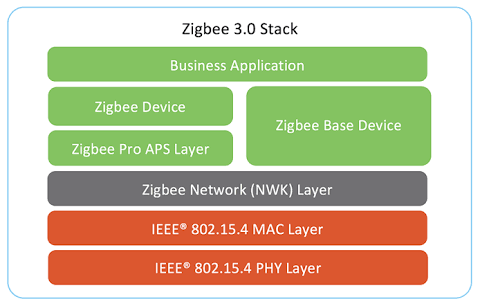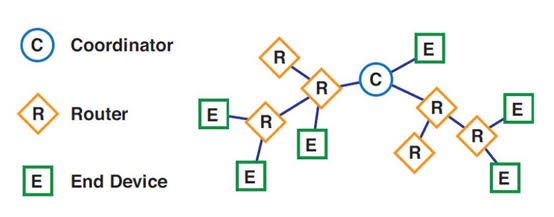
Zigbee is an IEEE 802.15.4-based specification for a suite of high-level communication protocols used to create personal area networks with small, low-power digital radios, such as for home automation, medical device data collection, and other low-power low-bandwidth needs, designed for small scale projects which need wireless connection. Hence, Zigbee is a low-power, low data rate, and close proximity (i.e., personal area) wireless ad hoc network.
The technology defined by the Zigbee specification is intended to be simpler and less expensive than other wireless personal area networks (WPANs), such as Bluetooth or more general wireless networking such as Wi-Fi. Applications include wireless light switches, home energy monitors, traffic management systems, and other consumer and industrial equipment that requires short-range low-rate wireless data transfer.
Its low power consumption limits transmission distances to 10–100 meters line-of-sight, depending on power output and environmental characteristics. Zigbee devices can transmit data over long distances by passing data through a mesh network of intermediate devices to reach more distant ones. Zigbee is typically used in low data rate applications that require long battery life and secure networking (Zigbee networks are secured by 128 bit symmetric encryption keys.) Zigbee has a defined rate of 250 kbit/s, best suited for intermittent data transmissions from a sensor or input device.
Zigbee builds on the physical layer and media access control defined in IEEE standard 802.15.4 for low-rate wireless personal area networks (WPANs). The specification includes four additional key components: network layer, application layer, Zigbee Device Objects (ZDOs) and manufacturer-defined application objects.
Typical application areas include:
Home Entertainment and Control—Home automation such as in QIVICON, smart lighting, advanced temperature control, safety and security, movies and music
- Wireless sensor networks—Starting with individual sensors like Telosb/Tmote and Iris from Memsic
- Industrial control
- Embedded sensing
- Medical data collection
- Smoke and intruder warning
- Building automation
- Remote wireless microphone configuration, in Shure Wireless Microphone Systems.
Zigbee devices are of three kinds:

Zigbee Coordinator (ZC): The most capable device, the Coordinator forms the root of the network tree and might bridge to other networks. There is precisely one Zigbee Coordinator in each network since it is the device that started the network originally (the Zigbee LightLink specification also allows operation without a Zigbee Coordinator, making it more usable for off-the-shelf home products). It stores information about the network, including acting as the Trust Center & repository for security keys.
Zigbee Router (ZR): As well as running an application function, a Router can act as an intermediate router, passing on data from other devices.
Zigbee End Device (ZED): Contains just enough functionality to talk to the parent node (either the Coordinator or a Router); it cannot relay data from other devices. This relationship allows the node to be asleep a significant amount of the time thereby giving long battery life. A ZED requires the least amount of memory, and, therefore, can be less expensive to manufacture than a ZR or ZC.
Source: Wikipedia